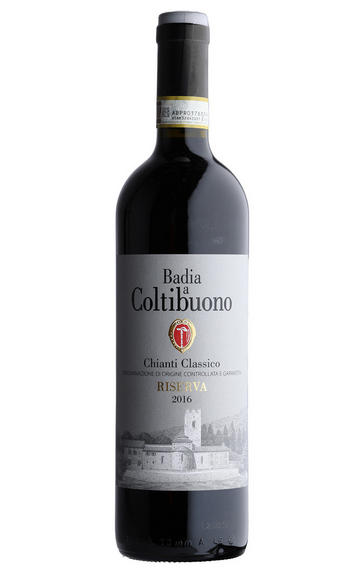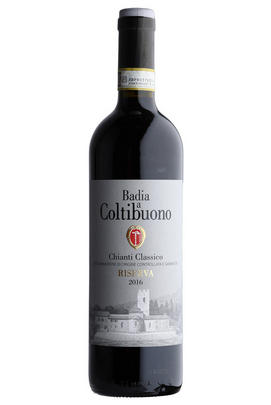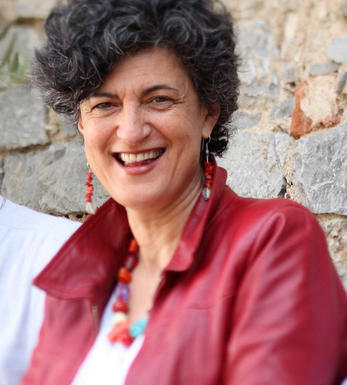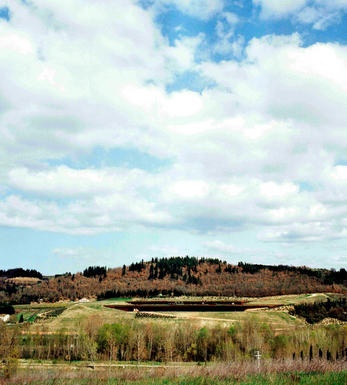
2016 Chianti Classico, Riserva, Badia a Coltibuono, Tuscany, Italy

Critics reviews
The 2016 Chianti Classico Riserva Badia a Coltibuono is a very pretty wine with lovely aromatic nuance and plenty of character to match its mid-weight personality. Crushed flowers, mint, lavender, spice and black cherry are all finely knit in this attractive, mid-weight Riserva. Fresh and energetic, the 2016 will drink nicely for many years to come.
Drink 2021 - 2031
Antonio Galloni, vinous.com (Jul 2019)
Showing beautiful results in an excellent vintage, the 2016 Chianti Classico Riserva is a graceful and elegantly tempered red wine. It makes good on all the basic promises of traditional Sangiovese: the complexity and elegance of the grape and that fresh acidity. It opens to a mid-weight style, making this a perfect wine for roast chicken and roast potatoes. Pretty mineral notes appear on the close, and the tannin is beautifully integrated.
Drink 2019 - 2033
Monica Larner, Wine Advocate (Sep 2019)
From Gaiole in Chianti. 90% Sangiovese, 10% Canaiolo, Ciliegiolo and Colorino. Lustrous mid ruby. Lifted cherry with minerally, saline notes and hints of crushed shells. Transparent, medium-bodied palate with fine yet gripping tannins. Fluid, sour-cherry fruit on the finish. Still embryonic, and with lots of potential.
Drink 2022 - 2034
Walter Speller, jancisrobinson.com (Apr 2020)
A pretty red, this features floral, strawberry, cherry and mineral aromas and flavors. A firm backbone and elegant frame mesh well, and this is poised for a long evolution. Fine length. 1,850 cases made.
Drink 2021 - 2038
Bruce Sanderson, Wine Spectator (Oct 2020)
Badia a Coltibuono traces its history back to the 11th century when Vallombrosian monks founded the abbey and started planting the area's first vineyards. The Stucchi Prinetti family who now own the property have bottles of Riserva dating back to 1937. Rounded out with a dollop of Canaiolo Nero, Ciliegiolo and Colorino, it is uncluttered by oak nuances. Accented by strawberry, juniper and tarragon, it glides smoothly across the palate with tame, chalky tannins and dusty black cherry on the finish. Accessible now, this has in bones to age gracefully over the next decade. I always appreciate the steadfast, recognisable personality of Coltibuono's elegant Riserva.
Drink 2020 - 2030
Michaela Morris, Decanter.com (Feb 2020)
The same blend, but aged 24 months in French and Austrian casks, the smaller production 2016 Chianti Classico Riserva offers a ruby/plum color as well as lots of baked cherry and redcurrant fruit interwoven with spice box, licorice, and sandalwood nuances. Medium-bodied, nicely concentrated, and balanced on the palate, it has more concentration as well as length and should benefit from a year or three of bottle age. It should keep for over a decade.
Drink 2021 - 2034
Jeb Dunnuck.jebdunnuck.com (Jun 2020)
About this WINE

Badia a Coltibuono, Tuscany
Located in Gaiole in Chianti, Badia a Coltibuono’s history dates back to 1051, to the Vallombrosan order of monks, whose fine abbey (‘Badia’ ) still stands proud at the heart of the wine property; ‘Coltibuono’ means ‘good crop’ by the way. Current owners, the Stucchi Prinetti family have only been in residence since its purchase in1846 by great great grandfather and Florentine banker Michele Giuntini, cousin of the Selvapiana family of Rufina.
The present generation, siblings Emanuela, Roberto, Paolo & Guido, now run the show, bringing this most traditional of wine estates up to date. At 74ha it’s no garage operation, but it is fortunate in owning a significant slice of subzone/sottozona Monti in Chianti, whose excellent terroir is much prized.
Another asset is their stock of ancient Sangiovese clones, which they have used to replant key sites at higher densities of 7-8,000 Sangiovese plants per hectare; as opposed to the ultra traditional pattern of low densities of red and white grapes.
In 1996 they built a new winery in Monti, and with the 2003 harvest their fruit was certified ICEA organic. Roberto Stucchi Prinetti remarks that since going organic they’ve noticed that the fermentations have been easier to follow. He adds that though they’ve sacrificed journalist ‘Points’ they’re more than happy with the pale elegance of their wines. They also produce a Chianti Classico Riserva.

Chianti Classico
Chianti Classico is a leading Tuscan DOCG zone which covers approximately 7,000 hectares between Florence and Siena. Its vineyards stretch into the Apennine foothills at altitudes of between 150m and 500m, and encompass two distinct terroirs and styles. The sandy, alluvial soils of the lower sites yield fuller, meatier wines while the limestone and galestro rocks of the higher vineyards deliver finer, more ethereal examples.
The origins of Chianti date back to the Middle Ages, although Chianti Classico was really born in 1716 when Grand Duke Cosimo III of Tuscany classified the zone, identifying the villages of Radda, Greve, Panzano, Gaiole and Castellina as the leading sites; these same villages still represent the nucleus of the Chianti Classico DOCG today. The regulations have been revised, however, to insist that the wine is made from a minimum 80 percent Sangiovese and a maximum 20 percent Canaiolo and ameliorative grapes (ie Merlot and Cabernet Sauvignon); from the 2006 vintage, no white grapes are allowed.
Chianti Classico cannot be released until 1st October in the year following the harvest, while Chianti Classico Riserva must undergo 24 months of ageing before release, including at least three months in bottle. At the region’s top addresses, French barriques are gradually being adopted in the place of the traditional, larger slavonian botte.
Recommended Producers: Monte Bernardi, Tenuta Fontodi, Castelo di Ama, Bibbiano

Sangiovese
A black grape widely grown in Central Italy and the main component of Chianti and Vino Nobile di Montepulciano as well as being the sole permitted grape for the famed Brunello di Montalcino.
It is a high yielding, late ripening grape that performs best on well-drained calcareous soils on south-facing hillsides. For years it was blighted by poor clonal selection and massive overcropping - however since the 1980s the quality of Sangiovese-based wines has rocketed upwards and they are now some of the most sought after in the world.
It produces wines with pronounced tannins and acidity, though not always with great depth of colour, and its character can vary from farmyard/leather nuances through to essence of red cherries and plums. In the 1960s the advent of Super Tuscans saw bottlings of 100% Sangiovese wines, as well as the introduction of Sangiovese/Cabernet Sauvignon blends, the most famous being Tignanello.


Buying options
Add to wishlist
Description
This reference-point Chianti Classico is grown in the hills around the village of Monti, outside Siena. The excellent 2016 vintage yielded wines of energy and brilliance; this Riserva is beginning to reveal its potential. This traditional blend is organically grown and aged in mixed oak botti for 24 months. The nose is a savoury Tuscan delight: black cherry, wild herbs, dried roses and baked earth. The palate is elegant but rich in flavour, with spice, sour plum and complex, savoury charm. There’s a tangy mineral freshness, and the tannins are firm yet remarkably fine and cleansing. Drink now to 2035+.
Davy Zyw, Wine Buyer (October 2020)
wine at a glance
Delivery and quality guarantee